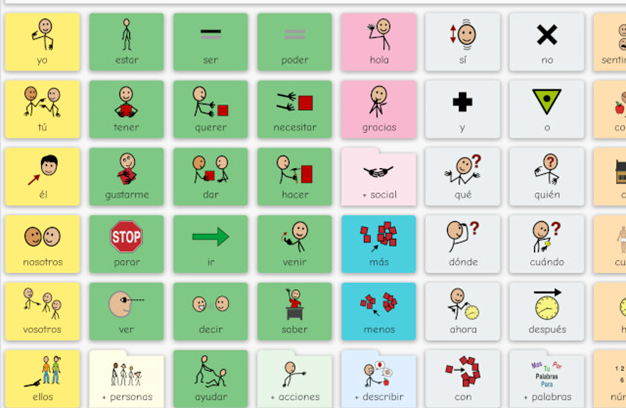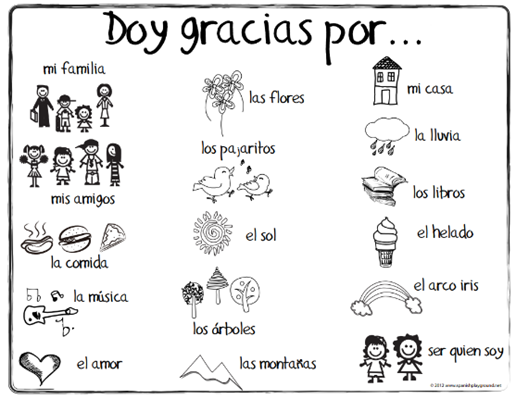Dar/Give
WAYS WE CAN USE THE WORD(S)
SHARE INFORMATION: e.g., Voy a dar un paseo (I’m going on a walk).
REQUEST: e.g., ¿Me das la manzana? (Will you give me the apple?)
DIRECT ACTION: e.g., Dame eso (Give me that).
REQUEST SUPPORT: e.g., ¿Me das la mano? (Will you give me your hand?)
SHOW AFFECTION: e.g., Quiero darte un abrazo (I want to give you a hug).
THANK: e.g., Te doy las gracias (I thank you).
EXPRESS A FEELING: e.g., Me da miedo (It scares me).
CONJUGATIONS FOR PRESENT AND PAST (PRETÉRITO INDEFINIDO)
|
SUBJECT |
PRESENT |
PAST |
|
I |
Doy |
Di |
|
You |
Das |
Diste |
|
He/She/You (Formal) |
Da |
Dio |
|
We |
Damos |
Dimos |
|
They/You All |
Dan |
Dieron |
This core word activity sheet was created by Angela Rowell. It was adapted from the School Year of Core Words worksheet for "give" by Amy Burt, who can be contacted @ amyaburt@gmail.com.
Snack/mealtimes: During mealtime or snack time, the adult can narrate the actions of various foods being given to the student, e.g., “Ahora te voy a dar la galleta” (Now I’m going to give you the cookie).
School Bus Stop: At the school bus stop, students who have already arrived can be prompted to wave to and welcome their friends as they arrive. The adult can prompt students by commenting “Tenemos que dar la bienvenida a nuestros amigos” (We have to welcome our friends).
Circle Time: Adults can reward students who behave well during circle time by placing Velcro or sticker gold stars on students’ personal Star Rewards charts. Adults can make comments such as, “Te voy a dar una estrella por tu buen comportamiento” (I’m going to give you a star for your good behavior).
Recess: When playing in the sandbox with students, the adult can prompt students to request the tools that they would like to play with, e.g., “¿Me das la pala, por favor?” (Will you give me the shovel, please?)
Guessing Game: In this game, students must guess how many steps it will take the adult to get from one location on the playground to another. The student who guesses closest to the correct amount wins. The adult can initiate the game by making comments such as, “¿Cuántos pasos tengo que dar para llegar al árbol?” (How many steps do I need to take to get to the tree?)
“Feeding” an Animal or Monster: The adult can initiate a game of pretend-play with a stuffed animal, animal figurine, or photo of an animal in the classroom, and can then prompt students to “feed” imaginary food to the animal. The adult can make comments such as, “¿Deberíamos dar de comer al perro?” (Should we feed the dog?).
Additionally, the adult can complement this activity by showing students the YouTube video “LOS COLORES - Damos de comer al Señor Pig, cerdito Antón Zampón | Aprender con Juguetes.”
Pin the Tail on the Donkey: The adult can prepare a game of Pin the Tail on the Donkey. A selected student will spin around while blindfolded, then remove the blindfold, and then attempt to pin a tail (made of paper) onto an image of a donkey that is stuck to a wall. The adult can instruct the students, “Da vueltas por 10 segundos” (Spin around for 10 seconds).
Here are some suggested books on YouTube that can assist in teaching the core word.
Books in Spanish:
- El libro de los abrazos: By Guido Van Genechten | Children's Book Read Aloud by A jugar
- This book teaches children the importance of hugs through many examples involving both the child protagonist and diverse animals. The adult can remind the student, “Es importante dar y recibir abrazos de vez en cuando” (It’s important to give and receive hugs sometimes).
- El lobo feroz quiere darte un beso: By Jean Leroy | Children's Book Read Aloud by Beatriz Montero
- This is the story of a grumpy and ferocious wolf which ends with the wolf needing to give and receive kisses in order to feel better.
- Iván no quiere compartir: By Roser Rius Camps| Children's Book Read Aloud by Miss Vanessa Miranda
- This is the story of Iván, a boy who never wants to share anything with anyone, but who slowly realizes the importance of sharing. The adult can accompany the story with comments such as, “Dar a los demás puede hacerte muy feliz” (Giving to others can make you very happy).
- ¿Me puedes dar una galleta, por favor? | Children's Book Read Aloud by CUÉNTAME UN CUENTO
- This is the story of Alfie, a little crocodile who desperately wants to find a way to get a cookie from his mom. He uses all types of creative strategies to try to get a cookie. Finally, he realizes that the best way to receive a cookie if to simply ask his mother if she would please give him one.
Bilingual Books:
- El Árbol Generoso - The Giving Tree in Spanish: By Shel Silverstein| Children's Book Interpreted by Spanish Fairy Tales
- A generous tree never stops giving fruit and support to the protagonist, despite the many changes occurring in the world. The protagonist eventually realizes the great value of the tree and the importance of living in harmony with nature. The adult can comment on the moral of the story with statements such as, “Tenemos que agradecer lo que la naturaleza nos da” (We have to be thankful for what nature gives us). This story is narrated in Spanish and has English subtitles.
- Si Le Das Una Galletita A Un Ratón (in Spanish with English translation and vocabulary): By Laura Numeroff| Children's Book Read and Interpreted by Ms. B’s Spanish
- This is the whimsical story of all the unexpected events that occur once a boy gives a mouse a cookie. This book is narrated in both Spanish and English.
Social Interactions: The adult can target both the social skill of sharing and the skill of counting by giving each student a turn to hold a bag of marbles (or other small objects). One by one, the other students can come up to the selected student to request a small number (between 1 and 5) of marbles, producing utterances such as, “¿Me das tres, por favor?” (Will you give me three, please?)
Video Modeling: Before special events (such as birthday parties or holidays) in which desserts or other special food items will be served, the adult can show students the Sesame Street video “Compartir galletas” so that students can watch how Elmo and the Cookie Monster model the act of sharing. The adult can make comments such as, “Mira cómo el Monstruo Comegalletas le dio la mitad de su galleta a Elmo” (Look how the Cookie Monster gave half of his cookie to Elmo).
Modeling: The adult can model how to find the verb “dar” on the student’s communication device and model how to combine the core word into multi-word utterances.

Students can take turns being blindfolded as the adult hands them various mystery items. The student must guess which item that adult has handed them. The adult can use utterances such as, “¿Qué te di?” (What did I give you?)
When requesting their sensory toys, students can be prompted to produce utterances such as, “Dame el/la _________, por favor” (Give me the _________, please).
Lesson on Time: The adult can give students a lesson on telling time, using this online resource of an interactive clock which allows you to change the position of the hands. While changing the time shown on the clock, adults can prompt students to make comments such as, “El reloj dio las 3” (The clock struck 3). Link to resource here.
Social Skills Lesson: The adult can prepare a lesson for students about sharing and “la importancia de dar” (the importance of giving). As part of this activity, the adult can share visual aids from the “Compartir es divertido” slides available for free on the teacherspayteachers website.

- Cinco Lobitos - Palmas Palmitas | Short Skit and Children’s Song | By Pica Pica
- While listening to this song, student can practice “dando palmadas” (clapping) in rhythm with the music. Watch the whole video or begin the video at the 2:30 mark to hear the lyrics “Palmas, palmitas, higos y castañitas. azucar y turrón, qué rica colección.”
- Canción para dar las gracias y decir por favor | Children’s Song | By Balloon and Ben
- Es mejor dar que recibir | Short Film for Children | By Agua Viva Valores
- A Pulgarcito lo invitaron a dar un vuelo | Children’s Song | By EducaBabyTV
- Aprendiendo a compartir con mis amigos| Children’s Song | By Little Angel Español - Canciones Infantiles
- This children’s song about sharing can be used in conjunction with lessons about phrases students can use when they are sharing classroom items, e.g., “¿Me das la pelota, por favor?” (Will you give me the ball, please?)
- Yo puedo dar saltos | Children’s Song | By El Reino Infantil
Art Activity: Students can be prompted to draw gifts that they would like to give to family members. The adult can prompt students by making comments such as, “¿Qué regalo le darías a tu mamá?”(What gift would you give to your mom?). Students can be prompted to think about the color, texture, size and other physical characteristics of gifts as they draw.
Giving Tree Artwork: After reading the Spanish version of The Giving Tree, students can draw their own version of a personal giving tree. Students can depict their trees as growing anything that they want (love, fruit, etc.). Students can produce utterances such as, “Mi árbol me da amor” (My tree gives me love).
A blank template of a printable tree that students can decorate and color can be found here.
Giving Thanks Art Activity: Students can color in “Doy gracias por” (I give thanks for) coloring sheets. Link to coloring sheets available on the spanishplayground website.
Example:

Tarheel Reader: Students can use Tarheel Reader to write books about the importance of being able to share and dar (give) toys and other acts of support to their friends. These books can then be shared with other students and read aloud.
Creating Videos: The adult can collaborate with students to record videos that model how to share and dar (give) toys and other acts of support to their friends.
WORD WALL: Create a Word Wall and add dar to the list.
READING and the Word Wall: Sound out the letters together. Have the students find the word on the AAC system.
WRITING and the Word Wall: Using a pencil or alternative pencil, have students try to type the word on the keyboard, adapted keyboard or write the word together.
Choosing Words for the Classroom Word Wall with Dr Caroline Musselwhite Video. Courtesy of Edmonton Regional Learning Consortium